

A History of the ‘Gay Agenda’ in Animation

Bit by bit, overtly gay characters are making inroads into animation targeted primarily at children. Cartoon Network’s Clarence recently attracted attention due to a scene of two gay men kissing on the cheek (not on the lips, despite what the show’s writers originally intended). Meanwhile, How to Train Your Dragon 2 includes a character who is implied to be gay—albeit only in a throwaway line ad-libbed by his voice actor. Are the days in which a homosexual man in Sailor Moon had to be rewritten as a woman for the English dub gone forever?
Such progress could never be made without a backlash, however. For years now, reactionary groups have been railing against this perceived indoctrination of children by seemingly innocent cartoons, and one character in particular stands as an emblem of this phenomenon: SpongeBob SquarePants.

This allegation—that the series SpongeBob Squarepants was created as pro-homosexual propaganda—actually began as something of an urban legend. In 2005 Focus on the Family founder James Dobson condemned the We Are Family Foundation–a campaign group which, amongst other things, opposes homophobia—for backing a children’s video that featured various cartoon characters, Spongebob being one of them. Dobson’s arguments were reported in the mainstream media with sensationalistic headlines such as “SpongeBob Accused of Promoting Homosexuality,” “Will Spongebob make you gay?,” and “Conservatives Pick Soft Target: A Cartoon Sponge,” and many assumed that Spongebob had—like Harry Potter a few years beforehand—fallen victim to an organized campaign from the fringes of the religious right.
Ironically enough, after the misreporting of Dobson’s comments, numerous fundamentalists came out and genuinely did accuse Spongebob of being gay. A typical example is David J. Stewart:
‘Then there’s the recent Sponge Bob Gay-Pants dilemma. Look… if you don’t want people to think Sponge Bob is homosexual, then don’t feature him in a “diversity” video which obviously is implying that sodomites should be accepted as well. The flashing colors of Sponge Bob are a clear indicator to me. Everyone knows that the rainbow has become the hallmark of the homosexual movement. By the way, nothing is any more blasphemous to the Bible than the Sodomites stealing of the rainbow. It is God’s rainbow, not the homosexuals!’
Perhaps it was inevitable that such accusations would be made. There is a long tradition of children’s television characters being condemned as homosexual: Tinky Winky was famously read as such by segments of the religious right, as were Bert and Ernie before him. All of this goes back at least as far as the Eighties, when Phil Phillips of Turmoil in the Toy Box infamy suggested that–with only one woman in their entire village–the Smurfs must have resorted to homosexuality somewhere down the line.
It is also worth mentioning that Spongebob was known to have a gay following years before Dobson made his comments. Creator Stephen Hillenburg has stated that he sees the character as asexual, but also understands why some aspects of the cartoon might appeal to the gay subculture.
This brings us to another, less grubby side of the same coin: cartoon characters who are read as homosexual not by detractors, but by fans. In the case of Spongebob, this is the result of subcultures appropriating aspects of mainstream pop culture—similar to how Judy Garland became a gay icon generations beforehand. Then we have fandom concept of “shipping,” in which fictional characters are paired up in ways not necessarily suggested by the story.
This phenomenon can sometimes feed puritan accusations. Take this email about a popular anime series, sent to the fundamentalist website Kjos Ministries:
‘I’ve noticed something alongside the occultic teachings that is rather disturbing. It also promotes the homosexual agenda. My 13 year old wanted to watch the show and before even thinking of allowing him to, I decided to do some research on the web and I found out that the main two characters, two 10 year old boys named Matt and Tai, are homosexual lovers. What’s even worse is that the show has an ADULT following as well. I found many fan sites run by adults that literally gush over how the two kids practice sodomy. Quite disturbing if you ask me.’
The anime in question is not some steamy boy’s love saga, but rather the children’s series Digimon.
It would be misleading to imply that all of this is the sole preserve of the religious right: secular commentators have come up with similar objections over the decades. The 1954 anti-comic manifesto Seduction of the Innocent by Dr. Fredric Wertham famously found homoerotic undercurrents in the pages of Batman and Wonder Woman: “the Batman type of story may stimulate children to homosexual fantasies,” wrote the psychiatrist.

Another interesting case can be found in Adam Parfrey’s 1987 anthology Apocalypse Culture, a book best described as an ideological freak show. One of the essays is “The Cereal Box Conspiracy Against the Developing Mind” by Michelle Handelman and Monte Cazazza; after reading incestuous connotations into the idea of Fred Flintstone consuming a bowl of Pebbles, the authors suggest that Barbie breakfast cereal is part of a scheme to make boys gay:
‘[T]he image of a scantily-clad Barbie showing lots of plastic flesh might be just the ideal breakfast companion for the developing heterosexual boy. The result of this may be to confuse a young boy’s sexual orientation. This may be welcomed by food manufacturers, for market surveys have found gay men to be more avid shoppers than their hetero counterparts.’
Such statements say far more about the people writing them then they do about the cartoons, comics, and cereal boxes that are under fire. We are now seeing openly gay characters in children’s animation, but this phenomenon bears little resemblance to the lurid ramblings quoted above.
The insidious gay agenda is winning—and this is what it looks like:

Pardon me for not exactly throwing my hands up in horror.

.png)